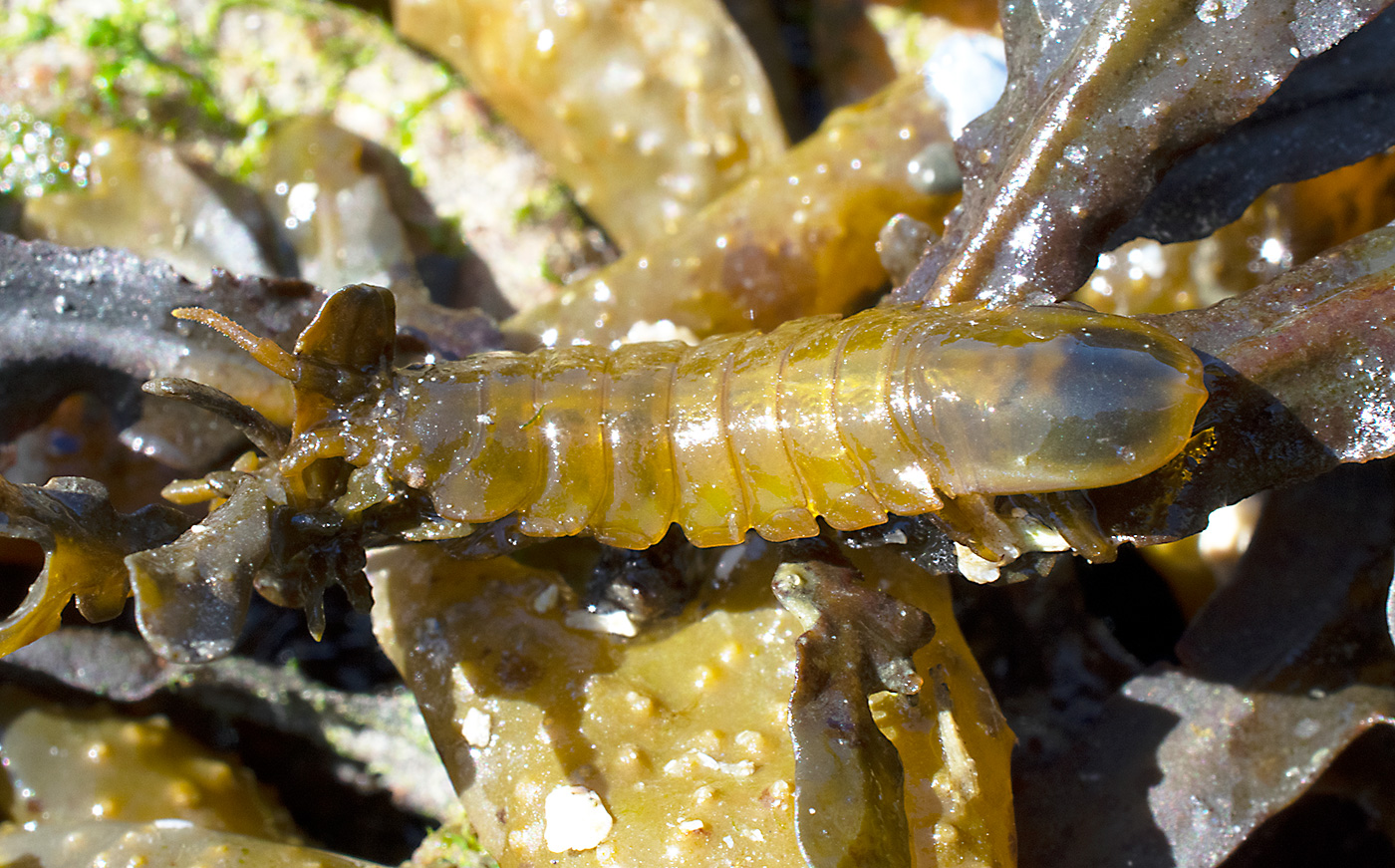Rockweed Isopod
Authors: Emma Hornell and Lilly Powell
Common Names: Rockweed Isopod or Kelp Isopod
Scientific Name: Idotea (Pentidotea) wosnesenskii
Size Range: 4cm (1.6 inches) in Length
Identifying features: Rockweed Isopods are related to terrestrial isopods (woodbugs) and are dorso-ventrally flattened with 7 pairs of clawed-tipped legs. The males are slightly larger than the females, are paler, and have thicker legs. The colour of individuals can vary from light green to olive green, brown, to black. It is dependent on their diet and can help them camouflage into their environment. For example some individuals found in coralline algae are very dark red in colour while those living amongst Rockweed (Fucus gardneri) are a dark olive green. Their bodies are segmented and flattened from top-to-bottom.

Rockweed Isopods (Idotea wosnesenskii) under a rock that has been turned over. A flatworm can be seen in the lower right. Arbutus Cove, Victoria, British Columbia.
Habitat: Rockweed Isopods can be found along the Pacific Coast from California to Alaska. They live in the intertidal zone and can be found under rocks or clinging to the holdfasts, stalks or blades of seaweed such as the Rockweed (F. gardneri). They are also sometimes found in mussel beds.
Prey: Rockweed Isopods are scavengers, surviving mainly on marine plants, algae and algal detritus, and occasionally the eggs of molluscs such as the Emarginate Dog Winkle (Nucella emarginata).
Predators: Rockweed Isopods have a myriad of different predators that likely include foraging shore birds and fish.
Behaviours: To protect itself from predators the Rockweed Isopod relies on camouflage and its ability to hold tightly to rocks and seaweed. Though some marine isopods are able to roll up into a small ball like their terrestrial relatives the Rockweed Isopod is not so flexible. The principally nocturnal creature, however, is a gifted swimmer, and will often flip onto its back and then use paddle-like appendages on its abdomen to maneuver itself around.
Life cycles: The average lifespan of a Rockweed Isopod is three to four years.
Reproduction: Rockweed Isopods reproduce around spring when the male fertilizes the female. The female Isopod holds her young in body pockets while they develop for three to four weeks, finally hatching as miniature adults.
Fun Fact: Idotea (Pentidotea) wosnesenskii was Named after Russian biologist Ilya G. Voznesenskii.
Original video by Aries
Video editing by Emma Hornell and Lilly Powell

References
Cowles, Dave. (2006). Idotea wosnessenskii. WWU: On Campus. Retrieved May 7th 2013 fromhttp://www.wallawalla.edu/academics/departments/biology/rosario/inverts/Arthropoda/Crustacea/Malacostraca/Eumalacostraca/Peracarida/Isopoda/Valvifera/Family-Idoteidae/Idotea_wosnessenskii.html
Houck, Becky; Fergusson-Kolmes, Linda; Kolmes, Steven; Lang, Terra. (n.d). Final Report on Intertidal Invertebrates in Tillamook Bay – A Report to the Tillamook Bay National Estuary Project. Department of Biology, University of Portland. Retrieved May 9th 2013 fromhttps://nrimp.dfw.state.or.us/web%20stores/data%20libraries/files/Watershed%20Councils/Watershed%20Councils_440_DOC_InvertebrateFaunaOfTillamookBay.pdf
Jamison, David. W. Kelp Isopod. Pugetsoundsealife.com. Retrieved May 7th 2013 fromhttp://www.pugetsoundsealife.com/puget_sound_sea_life/Kelp_Isopod.html
Pentidotea wosnesenskii. (2013, April 13). In Wikipedia, The Free Encyclopedia. Retrieved May 9th, 2013, from http://en.wikipedia.org/w/index.php?title=Pentidotea_wosnesenskii&oldid=550200397
Vancouver Sun. (May 2nd 2009). Urban critter: Rockweed isopod. canada.com | Join the discussion. Retrieved May 7th 2013 fromhttp://www.canada.com/vancouversun/news/westcoastnews/story.html?id=a16723b7-293d-4080-ab7b-671c4ddbc935

